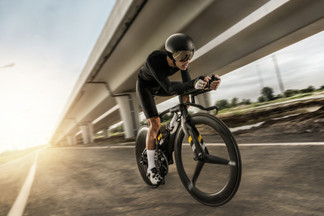Posted by A.J. Nygren on 20th Sep 2017
Aerodynamics in Triathlon
In triathlon the adversity you face isn’t just the race itself, the other athletes, or the brutality of the course. There is an omnipresent adversary on every course in every place. This adversary is wind, and boy oh boy can it be tough to beat. Lucky for us, everybody has to fight it and modern equipment companies put a lot of time, energy, and capital into minimizing the effects of this incredibly persistent beast. We know how to fight it in the water with ultra-buoyant wetsuits, tight swim caps, and race cut goggles but what about at points after transition one? In this post we will learn about the benefits of purpose-built bicycle equipment like aerobars, aero wheelsets, clothing, helmets, hydration solutions, and body position.
Let’s begin with you, the cyclist and the gear you wear. Not all bicycle clothing is equal in terms of aerodynamics. There is casual apparel that prioritizes comfort and then there is apparel built to race. If you’re riding along and you can feel your jersey whipping in the wind, you are losing efficiency and seconds that can turn into minutes. Companies like Louis Garneau and Castelli develop their high-end equipment with national or professional teams to ensure in real-world settings that their jerseys aren’t going to slow you down. The battle against the wind doesn’t stop there, though. Your helmet, water bottle position, and even your legs can help you shave time. A regular bicycle helmet is designed to keep you safe and cool but those ventilation holes can cause serious drag. Manufacturers such as Giro and POC make streamlined, smooth aero helmets that help the rider slice through the wind while offering the same impact protection on the bike. Your legs, (looking at the guys, here) can have a huge effect on your aerodynamics too. One bicycle company engineered their own wind tunnel and they found that shaving one’s legs can save well over a minute off of time over 40km. For the ladies, putting your hair in a ponytail instead of a bun saves about fourteen seconds over the same distance. Now let’s take a deeper look at the bicycle itself.
We need hydration while on the bike but your water bottle position may be costing you valuable time. The traditional braze-on mounts found on the downtube and seat tubes of most bicycles are very convenient but cause significant drag. X-Lab is a manufacturer of more aerodynamic hydration solutions and they offer a variety of options for storage. One of the easiest is a mount that holds the bottle behind the seatpost which allows air to go around the frame of the bicycle and not get caught up on a water bottle. If your bicycle is equipped with a standard drop bar, you could consider an upgrade to a set of aerobars that allow the cyclist to rest their elbows on pads up by the stem. This lowers the chest, head, and shoulders making for a smaller profile and much greater aerodynamics. There are also bottle mounts that will store an aerodynamic bottle in between the aerobars. These systems are great because they allow the triathlete to stay hydrated while in the aero position.
The wheels of the bicycle can also help you move forward through the wind. Regular bicycle rims don’t have much profile to them and just serve to be light and strong enough to take minor impacts. However, brands like Zipp and HED make super-slick aerodynamic wheelsets. Both of these manufacturers offer different depths of rims to suit different aerodynamic needs. A shallow rim offers some aerodynamic benefit and still allows for very nimble handling. There are also wheels known as “discs” that are literally a disc of carbon fiber. These wheels are the most aerodynamic but they are also heavier and don’t allow for the same maneuverability as a shallower rim. HED makes the iconic HED 3 which has three broad spokes instead of a disc or the 18-20 spokes seen on most models. This wheel is also very, very aerodynamic but the handling can suffer in high crosswinds.

